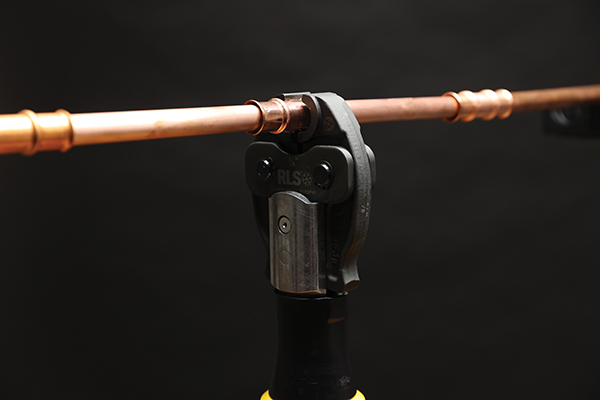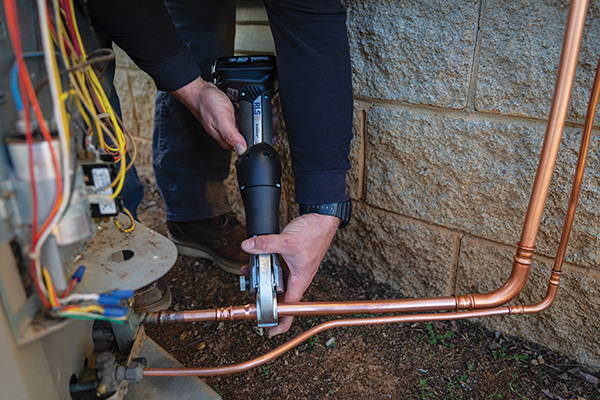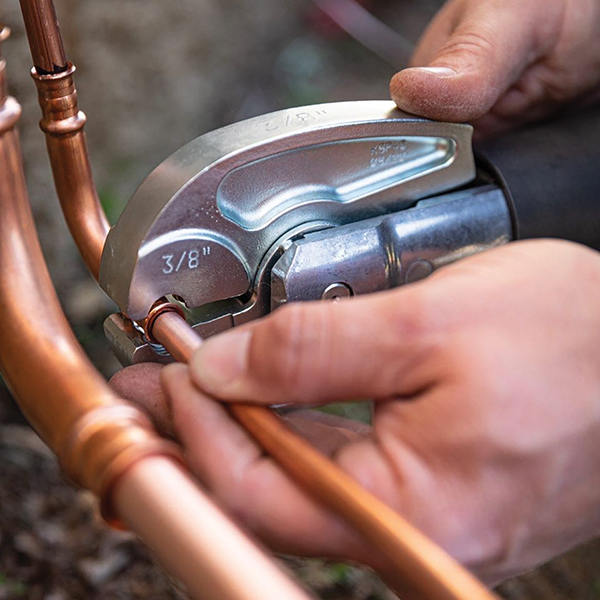
Improving Workflow and Increasing Profitability
June 2, 2023 | By Paul Schubert
Press fittings are gaining ground in HVAC/R projects as more contractors get on board and embrace the benefits.

Since they were introduced to the plumbing industry in the late 1990s, press fittings have become the preferred method of installation for plumbing contractors around the world. Creating safe, reliable and cost-effective pipe connections, it was immediately clear to plumbers that the benefits of press fittings outweighed those of the traditional brazing, welding and soldering processes.
Nearly 20 years later, HVAC/R contractors finally have a similar method of their own. Like their plumbing counterparts, HVAC press fittings offer an alternative to the conventional process of brazing, providing contactors and MROs with an added approach to joining HVAC/R lines that is not only consistent and reliable, but also enhances on-site efficiencies and overall profitability.
The only differences between HVAC/R and plumbing press fittings are the shapes of the fittings, the sealing agent inside and level of PSI approvals.
While hexagonal press fittings are standard in plumbing, circular press fittings were engineered to endure the high-pressure applications of HVAC/R.
The fittings are installed through a press-to-connect process that can be applied in a matter of just seconds, offering contractors a complete and permanent mechanical connection that is 60% faster than the traditional brazing method.
Although the adoption of press fittings by the HVAC industry has been slow, their popularity is steadily increasing. Since Rapid Locking System (RLS) first introduced press fittings in 2015, more than 15 million of these fittings have been installed worldwide and the demand is only expected to grow exponentially in the coming years.
Press Fits Improve Workflow & Profitability
It only takes about 10 seconds to install each press fitting properly and consistently, while brazing can take up to four minutes per connection, even for the experienced contractor.
While the investment in a press tool might seem steep initially, the long-term cost benefits of cutting down on brazing materials such as gas and mitigation supplies, coupled with efficient labour, outweigh the one-time upfront cost of these tools.
 Contractors with better on-site efficiency can complete projects in less time, which is often the component in pricing that can drive up costs the most and make or break a customer’s decision to accept a bid on their project.
Contractors with better on-site efficiency can complete projects in less time, which is often the component in pricing that can drive up costs the most and make or break a customer’s decision to accept a bid on their project.
HVAC/R repairs and installations can be completed successfully by fewer people and in significantly less time with press fittings. The quicker installation timeline reduces both the cost of labour and materials, which can help contractors boost productivity and their overall profitability, as well as potentially secure more projects.
The ability to conduct a flameless installation is also a compelling selling point for bids on projects where an open flame poses risk to structures and their occupants, or in situations that would force clients to halt their own work due to hot work permit regulations.
Because of their flameless advantage, press fittings are often used for projects at historical buildings, industrial sites or health care facilities.
Another way in which press fittings can improve workflow is by the consistency in replication that the tool offers. While the success of brazing depends on the skill of the contractor, press fittings are installed with a tool and jaw that handles most of the work and require very little training to use. This automatic process means connections are consistent between technicians and easily repeatable.
“Press enables me to do repairs where I couldn’t do them before. Take hospitals, for example, where oxygen is present and brazing isn’t an option,” says Mike Cameron, a contractor with J.J. & A. Mechanical in Vancouver. “It also makes my clients happy that I can get jobs done quicker because I don’t have to wait around for a hot work permit.”
Health & Safety Benefits
No matter how skilled or experienced a contractor is, brazing always poses a fire risk. Press fittings never require the use of an open flame, which eliminates a source of fire hazards. In fact, installing press fittings completely removes the need for added fire precautions including hot work permits, fire spotters and fire safety equipment.
Using an alternative method to brazing also comes with fewer health concerns for users. While the most obvious threats to health and safety from brazing are the fire hazards that come with it, there are many other ways in which contractors are at risk.
Brazing poses a serious risk of accidentally ingesting unsafe gases, insulation, and dust for contractors working near the materials.

And no matter the weather, contractors are expected to show up and get the job done – even if it means braving the harsh Canadian winters or the unseasonably warm summers.
With press, you don’t have to worry as much about these health and safety implications. Connections are made in just seconds and there’s no torch needed, significantly decreasing the amount of time spent out in the cold or next to a flame in a hot attic.
Inexpensive Training
One of the more convincing aspects of using press versus brazing is the incredibly short learning curve. Unlike brazing, learning how to install press fittings doesn’t require years of supervised training and dedicated practice.
Both skilled contractors and inexperienced apprentices can learn how to properly prep tubing, operate a press tool and install the perfect fitting in just a single training session.
Although it may be easy to pick up, that’s not to say that training isn’t necessary. Contractors need to understand how to properly use press fittings to ensure a quality connection.
“Any leaks that I’ve witnessed in my two years of using press has always been due to bad install practice,” explains Gary McCreadie, owner of McCreadie HVAC & Refrigeration Services and founder of HVAC Know It All.
Despite the versatility and broader applications that press fittings can offer, most trade schools aren’t training apprentices on how to install them yet.
It’s up to employers to introduce press to young technicians or find someone else who can. The good news, though, is that it won’t be nearly as much of a burden to train on press than it is to supervise their attempts at brazing.
And it’s only a matter of time before apprenticeship programs catch up.
While the benefits of press are undeniable, brazing will always remain a key skill in the trade as both provide solid connection solutions.
While press tools do all the work of creating the connections, tube ends are prepared similarly to the way they would be for the brazing process and there are some instances where brazing is more ideal.
For many contractors, press fittings can be another tool to add to their installation arsenal to ensure an efficient workflow and improve the company’s bottom line. <>




